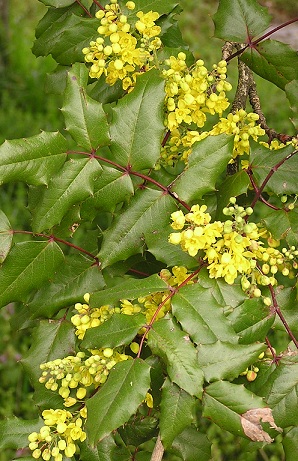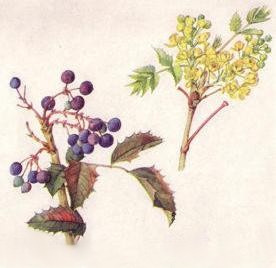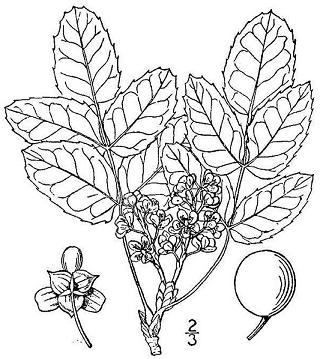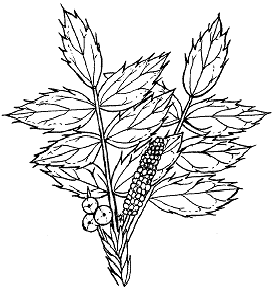|
|
|
Hansen's Northwest Native Plant Database |
|
|
Northwest Native Oregon Grape (Mahonia aka Berberis) |
|
 |
|||||||||||||||||||||||||||||||||||||||||
|
General Information For This Genus Click on links at bottom of this page for photos and details of each plant. |
||||||||||||||||||||||||||||||||||||||||||
|
While Tall Oregon Grape grows 5 - 10 feet tall, the Cascade Oregon Grape is only 2 feet tall. It's leaves are longer than it's tall relative. A good plant for filling in spaces where you want a hardy, colorful plant with no care required. The Creeping Oregon Grape is one of our favorite ground covers. It has the same features as the other two grapes but grows about 12 - 18" tall. Even grows well where the climate gives hot summers and cold winters. The leaves have sharp points, perfect for planting under a bedroom window or as a hedge to discourage unwanted visitors. Brighten a shady corner with the Tall Oregon Grape in the background, Cascade Oregon Grape in the middle and Creeping Oregon Grape groundcover. Wow! The Northwest Native Mahonia (Oregon Grape) is a beautiful and very useful ornamental shrub from the Western USA. Once known as Berberis, the currently accepted scientific name is Mahonia. Common names for this genus include Barberry and Holly-Grape. |
||||||||||||||||||||||||||||||||||||||||||
| Use in every northwest garden. Tends to form clumps. If this beautiful plants gets too tall or "leggy" prune it back rather hard if you wish. This species found on dry to moist well drained sites, sun or shade, from British Columbia to Northern California on the west side of the Cascade Mountains and in northeast Oregon. Birds and animals love the fruit rather tart and seedy. It does make a very good jelly! Florists use the foliage of this shrub for greenery. | ||||||||||||||||||||||||||||||||||||||||||
Culture:
Mahonia is nursery propagated from seed and
germination can be a problem. The most common nursery practice is to sow
fresh seed in the Fall and let a cold winter break the seed dormancy. When
transplanting in the early Spring, expect the existing leaves to die back
and a bit later, new buds will form.
Mahonia are succeptible to few diseases, at least here in Oregon. However, Leaf Spot or Rust are occasionally a problem. Rust can be treated with a fixed copper spray or Daconil. Always remove and destroy infected leaves. Though the leaves remind one of holly, the mahonia shrubs native to the northwestern United States offer much more than the China native Ilex. Tall Oregon Grape is our Oregon State flower and we're very proud of this wonderful northwest native shrub with year-round beauty. The plant appears in late spring with glossy bronze foliage and yellow flower buds just ready to bloom. Later we see the golden yellow blooms, the dark green leaves and the blue berries. There are Tall Oregon Grape (Mahonia aquifolium), the Cascade Oregon Grape (Mahonia nervosa) and the Creeping Oregon Grape (Mahonia repens). M. aquifolium is a great hedge plant, reaching 5-10 ft tall at maturity. M. nervosa is shorter, about 2-3 ft tall and M. repens is the hardy ground cover, only 12-18. Landscape idea: Mahonia Cameo Planting. For a lovely corner, plant Three Tall Oregon Grape (Mahonia aquifolium) at the back, a cluster of 3-5 Cascade Oregon Grape (Mahonia nervosa) in the center, and a necklace of 5-7 Creeping Oregon Grape (Mahonia repens) at the front edge. Or create an oval shaped island or a container to be viewed from all sides by planting 1-3 M. aquifolium in the center, a larger circle of 3-5 M. nervosa and finish with a chain of M. repens around the perimeter. Your Mahonia Cameo will grow quickly and the easy-care hardy plants will delight all year. |
||||||||||||||||||||||||||||||||||||||||||
| There are four Mahonia species native to Oregon. These are wonderful plants, each with different characteristics each useful for different purposes. They have tough, evergreen leaves, edible dark blue, fruit and attractive yellow flowers. All have yellow inner bark and spread by underground runners. Leaves are alternate, pinnately compound with 3 to 21 leaflets, depending on the species. All northwest Mahonia develop some bronze leaf colors in the sun: they stay greener in the deeper shade. |
 |
|||||||||||||||||||||||||||||||||||||||||
|
Species Information For This Genus Click on links below for photos and details of each plant. |
||||||||||||||||||||||||||||||||||||||||||
|
As yet, not all northwest native mahonia are covered in this website, though that may be done some time in the future. For now, we have information about only three of our northwest native mahonia. |
||||||||||||||||||||||||||||||||||||||||||
| Mahonia aquifolium (Tall Oregon Grape): This superb evergreen shrub is the State flower of Oregon. Can get 10 ft tall, but usually 5 ft in gardens. Large clusters of small golden yellow flowers on shiny dark green, holly-like foliage in the spring. New growth is copper color in the spring. Blue fruits are tart - often used for jelly. Use for hedges, borders and drifts. Sun or shade (fairly tolerant of shade). Drought tolerant. Perfect for the northwest and all similar climates. |
 |
|||||||||||||||||||||||||||||||||||||||||
| Mahonia nervosa (Cascade Oregon Grape, Long Leaf Oregon Grape, Dwarf Oregon Grape): Flowers and berries are nearly identical to Mahonia aquifolium, above, but this is a low growing plant. Similar to Tall Oregon Grape, but longer leaves and a different form -- 2 ft tall. Same beautiful flowers and fruit as Tall Oregon Grape. Widespread in open forest areas. Excellent ground cover. Likes part shade. and is tolerant of deep shade. Probably more plentiful in western Oregon than Tall Oregon Grape. This plant seldom gets over 30 inches tall and has long leaf stems to 16 inches and 11 to 21 leaflets, all dark glossy green. Also used by florists for arrangements. Loved by birds and animals. Same yellow flowers and dark blue, edible fruit. Found from British Columbia south into northern California and in northeastern Oregon and Idaho. |
 |
|||||||||||||||||||||||||||||||||||||||||
| Mahonia repens (Creeping Oregon Grape): Low growing, spreading evergreen ground cover (10-14"). Superior ground cover of the Oregon Grape species. Dull green leaves, yellow flowers, blue-purple edible fruits. (Note the dull leaves distinguish this species from the other two. Likes sun or shade. Has 3 to 7 leaflets. Recommended to cover large open areas not suitable for lawn. Will often take root at the nodes. Drought resistant after established. Browsed by some deer. Found in dry, sun or shade areas in well drained sites on the east side of the Cascades from British Columbia to northern California and east into Idaho. Also found in the Sierra Nevada Mountains, the Rocky Mountains and the Black Hills. Brilliant fall color! |
 |
|||||||||||||||||||||||||||||||||||||||||
|